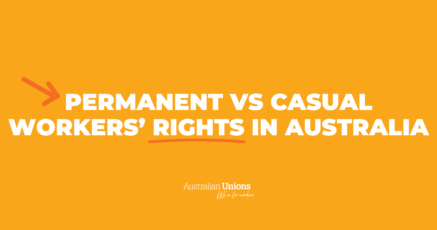Scored an apprenticeship? Big congrats. Before you lace those work boots and sign on the dotted line, there’s a mountain of paperwork you’ll need to tackle.
And once everything’s official, it’s time to finally share the good news … you’re employed, thriving, and one step closer to that qualification. Well done, you.
But first, that mountain of paperwork. A (sometimes) arduous and confusing, but necessary task that waits for no one. Luckily, you have union power to boost you along the way.
Here are four steps to getting it right the first time and not being ripped off in the process.
1. Know what should be included in your training contract
Your training contract outlines your rights and obligations (as well as your employer’s). Basically, if there’s one document that’s worth over-analysing, it’s this one.
Already received your training contract? Before you print your signature, here’s a checklist of what should be included:
- Duration of the contract
- Trade
- Qualification you will study
- Hours of work
- Who will deliver and assess your progress
- How/when the training will be delivered
- The Award or enterprise agreement that will specify other conditions of employment like wages, penalty rates, leave etc.
A few additional things to note
- After employing an apprentice or trainee, employers have 14 days to contact an Apprenticeship Network provider to initiate the signing and registration of the training contract.
- Once your probationary period is done and dusted, the contract can’t be terminated without the approval of the relevant state/territory apprenticeship authority (unless both you and your employer agree to part ways).
- If you notice that something is missing from your training contract? Flag it.
- Remember – without a training contract in place, you may be deemed to be a labourer, and your pay and employment conditions must match that classification. i.e you should be receiving a higher wage.
Employers can get in big trouble if they treat you like an apprentice but you’re not on a training contract. If you’re at the point where you realise you don’t have a training contact at all, contact your union straight away.
2. Know your rights
- You should always be kept in the loop – this means that your employer must discuss changes with you before making them.
- For most apprentices, trade progression is based on competency, rather than time. So it doesn’t necessarily take, say 4 years, to receive your qualification. Some apprentices may complete their training sooner.
- Unless you are a pre-existing employee, your employer is not obligated to continue your employment once your apprenticeship is over. That’s why it’s best to ask your employer what their future plans are sooner rather than later.
3. Help your future self by sorting out your super, now.
When you start a new job, you’ll be handed superannuation papers to fill in. Superannuation is money paid into a fund by your employer, for you to access in retirement.
And sure, retirement may seem like something for future you to deal with – but you want to start loading those dollars into your super fund to set yourself up for later.
Super is paid on top of your wages and is calculated as a portion of your pay, and you can choose which superannuation fund you would like to use.
Since the late 1990s, the superannuation guarantee – the minimum amount an employer must contribute – has increased incrementally to reach 10.5 per cent, and it will reach 12 per cent in 2025.
4. Study your payslips. Study hard
Whether you receive payslips on a weekly, fortnightly or monthly basis, block out a time in your calendar to review your payslips so you don’t forget. It may be tempting to file them away and forget, but you could be missing out on extra pay because of it. A good way to avoid this is to check your payslips as soon as you receive them. Keep in mind:
- If you are 21 or older when you start your apprenticeship, you are entitled to adult wages.
- You must be paid for all hours worked, including overtime.
- Your employer is legally required to give you a payslip each time you are paid. Whether it’s a physical or a digital copy, you must receive access to it within one working day of being paid.
- You may be entitled to special payments on top of your wage such as a tool allowance or uniform allowance.
- If you do discover that the numbers aren’t adding up, then you have likely had your wages stolen. In this instance, give your union a call because they can help you recover stolen wages, even up to six years after it happens.
Apprenticeship rights, all wrapped up
- As an apprentice, you can’t be fired for exercising a workplace right or for refusing to work in unsafe conditions.
- Your employer has a duty of care to you as an apprentice, to make sure you are correctly trained, supervised and not treated poorly at work.
- Your apprenticeship may be extended or shortened.
- TAFE fees must be reimbursed or paid for by your employer.
- The best way to check if your employer is correctly paying your wages and superannuation contributions is to look at your payslips.
Need help finding your feet at work? Contact us today. We’ll answer all the tough questions and help you take action regarding your wages and working rights.
Your union is there to help with more than just pay and super. If you don’t feel safe at work or a worried about some safety practices on-site, call your union straight away. Just because you’re an apprentice, doesn’t mean you have put up with risky situations.
We know being an apprentice can be challenging so many unions will provide lower fees to accommodate your role. All fees are tax-deductible. And payment options are always open for discussion, whatever your position.







SHARE:
How to prepare for your first apprenticeship